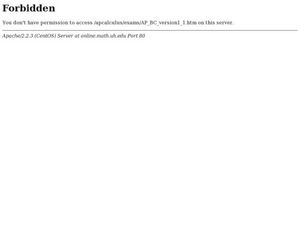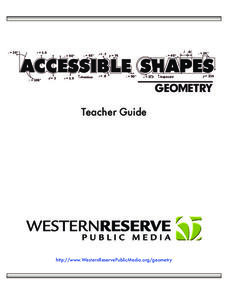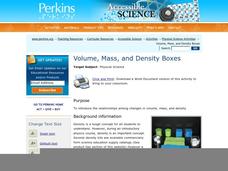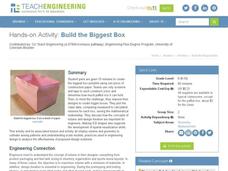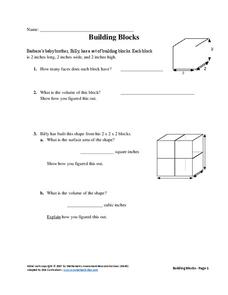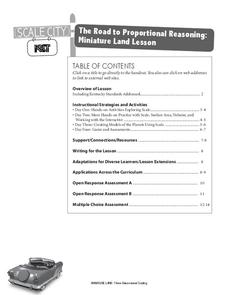Curated OER
Size Them Up
Students arrange containers by their capacity. In this volume instructional activity, students place containers in order by increasing capacity. Students discuss how the tallest container doesn't necessarily hold the largest amount.
Curated OER
AP Calculus Practice Exam: BC Version - Part A
In this calculus worksheet, students solve 28 multiple choice problems. Students find derivatives, volumes, limits, convergent series, etc.
Curated OER
Observing Sound
Second graders study the five senses and the link between pictures and sound. In this sound lesson students discover that sound is vibration, it is described by volume and pitch.
Curated OER
Calculate Volume and Surface Area
In this volume and surface area instructional activity, students are given the volume of 4 figures and find the area. A web site reference is given for additional activities.
Charleston School District
Solving for a Missing Dimension
If a can has a volume of twelve ounces, how tall it should be? If you can work with volume formulas, it's is an easy measurement to find. After finding the volume of figures in the previous lesson of the series, learners now apply the...
EngageNY
End-of-Module Assessment Task - Geometry (module 3)
It's test time! Determine your class's understanding of the topics of volume and cross sections with a thorough assessment on volume, area, and geometric shapes.
Noyce Foundation
Building Blocks
Building blocks have more uses than simply entertaining children. Young mathematicians calculate the volume of a given cube, and then calculate the volume and surface area of a prism formed from multiple cubes.
EngageNY
Cones and Spheres
Explore methods for finding the volume of different three-dimensional figures. The 20th lesson in the 25-part series asks learners to interpret diagrams of 3-D figures and use formulas to determine volume. Scholars must use the...
PBS
Accessible Shapes
All the 2-D and 3-D measurement work you need is in one location. Divided into three sections, the geometry lesson plans consist of visualization of three dimensions, classifying geometric figures, and finding surface area and volume....
Balanced Assessment
Boring a Bead
How much material is in a bead? Class members utilize volume formulas to determine the amount of material in a bead. The goal of the assessment is to show that the amount of material left in a bead is the same for all beads with a given...
CCSS Math Activities
Smarter Balanced Sample Items: 8th Grade Math – Target I
A slideshow covering the Smarter Balanced Target I on solving problems involving volume of cylinders, cones, and spheres contains five sample items. Items range from finding the volume of a figure to finding the altitude of a cone given...
Mathematics Assessment Project
Glasses
Clink, clink! Young mathematicians investigate drinking glasses composed of known solids (cones, cylinders, and hemispheres). Next, they determine the volumes of these glasses.
Perkins School for the Blind
Volume, Mass, and Density Boxes
Mass and density are difficult topics for kids to understand, and even more difficult when you have visual impairments or blindness. Learners will make boxes and fill them with cotton, sand, or crushed paper. They will feel the density...
Illustrative Mathematics
How Many Cells Are in the Human Body?
Investigating the large numbers of science is the task in a simple but deep activity. Given a one-sentence problem set-up and some basic assumptions, the class sets off on an open-ended investigation that really gives some context to all...
Mathematics Vision Project
Module 5: Modeling with Geometry
Solids come in many shapes and sizes. Using geometry, scholars create two-dimensional cross-sections of various three-dimensional objects. They develop the lesson further by finding the volume of solids. The module then shifts to finding...
Teach Engineering
Build the Biggest Box
Boxing takes on a whole new meaning! The second installment of the three-part series has groups create lidless boxes from construction paper that can hold the most rice. After testing out their constructions, they build a new box....
Virginia Department of Education
Attributes of a Rectangular Prism
A change is coming. Pupils use unit cubes to investigate how changes in the length, width, and/or height affects volume and surface area. They extend the results to write and test predictions on the effect of changing multiple sides on...
CCSS Math Activities
Building Blocks
Math is a lot like building blocks—it requires a solid foundation. A short performance task has pupils consider the volume of a cubic block. It then asks mathematicians to find the surface area and volume of a prism made from stacking...
CCSS Math Activities
Golf Balls
Land on the green with a fun resource. A short performance task asks pupils to consider the volume of containers that hold golf balls. They determine the percentage of empty space of the container for different numbers of golf balls.
Indian Institute of Technology
Could King Kong Exist?
The title says it all: Could King Kong exist? Investigate how increasing the dimensions of an object affects its surface area and volume to mathematically conclude whether a creature with the weight and height of King Kong could actually...
Teach Engineering
Determining Densities
Don't be dense—use a robust resource. The second installment of a five-part Floaters and Sinkers unit has learners determine the densities of several objects. As part of the activity, they learn the displacement method for finding...
Kentucky Educational Television
The Road to Proportional Reasoning
Just how big would it really be? Young mathematicians determine if different toys are proportional and if their scale is accurate. They solve problems relating scale along with volume and surface area using manipulatives. The last day of...
Charleston School District
Review Unit 8: Geometry Applicaitons
Pupils complete a review worksheet that highlights the key problems from the first eight lessons in the series. Topics include the Pythagorean Theorem and its converse, as well as finding volume of three-dimensional figures.
Mathematics Assessment Project
Evaluating Statements About Enlargements
Double, toil ,and double linear dimensions. Learners first complete an assessment investigating how doubling linear dimensions affects the area of pizzas and the volume of popcorn containers. They then complete an activity investigating...
Other popular searches
- Volumes of Solids
- Geometry Nets Volumes
- Volumes of Revolution
- Volumes of Prisms
- Calculus Volumes
- Measuring Volumes
- Volumes and Surface Areas
- Volumes of Cylinder and Prisms
- Volumes of Spheres
- Measuring Volumes Beakers
- Activities on Volumes
- Measuring Volumes of Liquide



